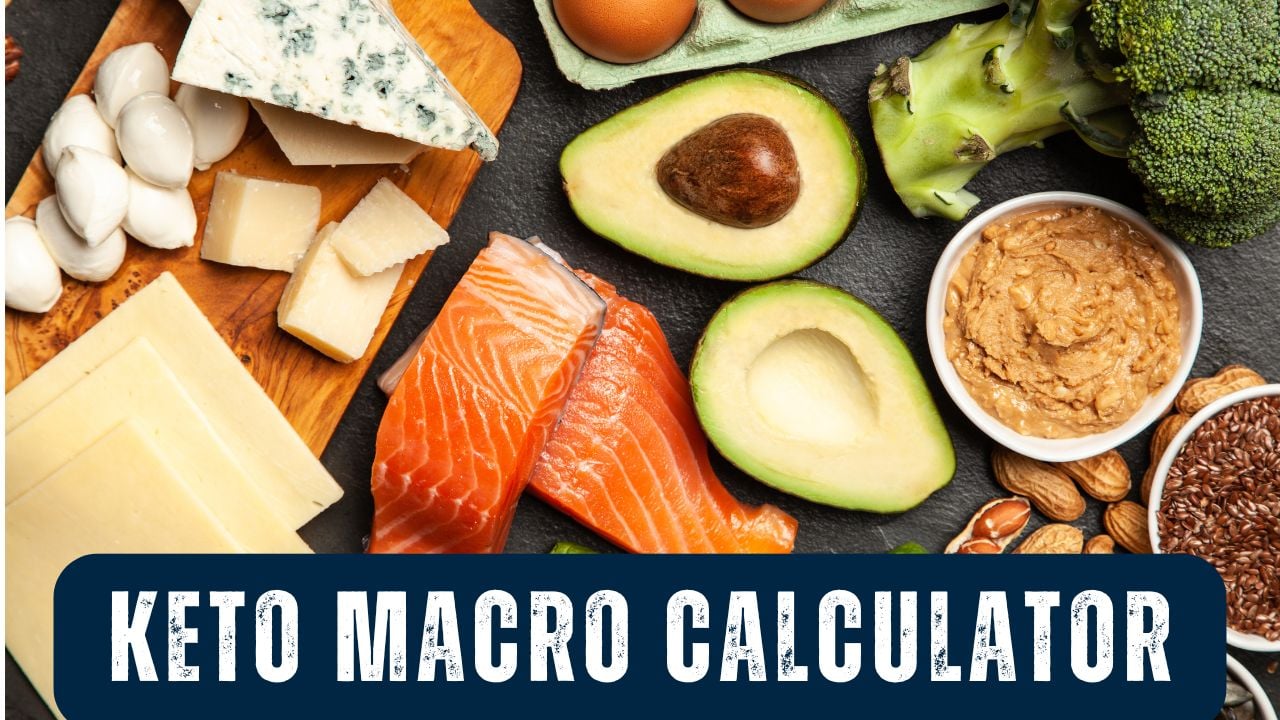🥑 Keto Macro Calculator
Calculate your perfect ketogenic macros for optimal ketosis, fat loss, and metabolic health

📊 Progress Tracking
Track your weight loss, measurements, and ketone levels over time
📝 Log Entry
📈 Progress History
No progress data yet. Start logging to see your journey!
📊 Progress Charts
🧪 Ketone & Glucose Tracker
Monitor your ketosis levels and calculate your Glucose-Ketone Index (GKI)
🧮 GKI Calculator
📝 Log Ketone Reading
📈 Ketone History
No ketone readings yet. Start tracking to monitor your ketosis!
🥑 Keto Food Database
Search USDA database for keto-friendly foods and their macros
🧬 Your Keto Journey
Track your adaptation phases and get personalized guidance
🚀 Start Your Journey
Enter your keto start date to track your adaptation progress and get personalized guidance for each phase.
What is the Ketogenic Diet?
The ketogenic diet is a high-fat, moderate-protein, low-carb eating pattern that induces ketosis. In this state, your body burns fat instead of glucose for energy. Research shows keto diets are effective for weight loss and metabolic health.
Standard keto macros: 70% fat, 25% protein, 5% carbs (20-50g daily). Your body enters ketosis within 2-4 days, converting fatty acids into ketones that fuel your brain and muscles.
📊 How Keto Macros Are Calculated
We use the Mifflin-St Jeor equation to calculate your BMR, then adjust for activity and goals:
Women: BMR = (10 × weight kg) + (6.25 × height cm) – (5 × age) – 161
TDEE: BMR × Activity Factor (1.2-1.9)
Goal Adjustment: Fat Loss (-20%), Maintain (0%), Gain (+20%)
Protein 25%: 2168 × 0.25 ÷ 4 = 136g
Carbs 5%: 2168 × 0.05 ÷ 4 = 27g
Keto Diet Approaches
🥑 Standard Keto (70/25/5)
Classic approach with 70% fat, 25% protein, 5% carbs (20-25g daily). Best for beginners, weight loss, and blood sugar management.
💪 High-Protein Keto (60/35/5)
Modified ratio: 60% fat, 35% protein, 5% carbs. Ideal for athletes, muscle building, and active individuals. Higher protein preserves muscle during fat loss. Use our protein calculator for personalized targets.
🏃 Targeted Keto (65/25/10)
Strategic carbs (25-50g) before workouts. Best for high-intensity training and athletes. Supports performance without compromising ketosis throughout the day.
Keto Macro Recommendations by Goal
| Goal | Calorie Adjustment | Recommended Approach | Daily Carbs | Expected Results |
|---|---|---|---|---|
| Aggressive Fat Loss | -25% from TDEE | Standard Keto (70/25/5) | 20-25g net carbs | 1-2 lbs/week weight loss |
| Moderate Fat Loss | -20% from TDEE | Standard/Moderate Keto | 20-30g net carbs | 1-1.5 lbs/week weight loss |
| Mild Fat Loss | -10% from TDEE | Moderate Keto (65/30/5) | 25-35g net carbs | 0.5-1 lb/week weight loss |
| Maintenance | TDEE (no change) | Any keto approach | 20-40g net carbs | Maintain weight & health |
| Lean Muscle Gain | +10% above TDEE | High-Protein Keto (60/35/5) | 25-40g net carbs | Slow lean mass gain |
| Muscle Building | +20% above TDEE | High-Protein/TKD | 30-50g net carbs | Muscle gain with minimal fat |
Note: These recommendations are based on ketogenic diet research. Individual responses vary. Track your progress and adjust as needed. Use our TDEE calculator and body fat calculator to monitor changes.
Keto-Friendly Foods
🥑 Best Fat Sources
- Oils: Olive oil, coconut oil, MCT oil, avocado oil, butter, ghee
- Whole Foods: Avocados, olives, fatty fish (salmon, mackerel), nuts, seeds
- Dairy: Heavy cream, cream cheese, full-fat yogurt, aged cheeses
🍖 Protein Sources
- Meat: Beef, lamb, pork, bacon (sugar-free)
- Poultry & Fish: Chicken, turkey, salmon, tuna, shellfish, eggs
- Plant-Based: Hemp seeds, pumpkin seeds
Target: 0.8-1.2g per lb lean mass. Use our protein calculator for personalized needs.
🥬 Low-Carb Vegetables
- Leafy Greens: Spinach, kale, lettuce, arugula (< 1g net carb per cup)
- Cruciferous: Broccoli, cauliflower, Brussels sprouts, cabbage
- Others: Zucchini, cucumber, asparagus, bell peppers, mushrooms
Avoid: Potatoes, corn, peas, rice, bread, pasta, sugary fruits, legumes, processed foods.
What is Ketosis?
Ketosis occurs when your body burns fat for fuel instead of carbs. By restricting carbs to 20-50g daily, your liver converts fatty acids into ketones that fuel your brain and muscles.
Webmd shows ketosis begins in 3-4 days and reaches optimal levels in 1-2 weeks. Target blood ketones: 0.5-3.0 mmol/L.
✅ Signs of Ketosis
- Increased Energy: Sustained energy after 1-2 weeks adaptation
- Reduced Hunger: Natural appetite suppression
- Mental Clarity: Improved focus and cognition
- Fruity Breath: Acetone release through breath
- Weight Loss: Initial water weight, then steady fat loss
Blood ketone meters (0.5+ mmol/L) are most accurate. Urine strips work initially but become unreliable after adaptation.
⚠️ Avoiding Keto Flu
Temporary symptoms (fatigue, headaches, cramps) occur in the first week due to electrolyte loss. Duration: 3-7 days.
Potassium: 3000-4000mg (avocado, spinach, salmon)
Magnesium: 300-400mg (supplement or dark chocolate, seeds)
Water: 2.5-4 liters daily
💡 “Ketoade” Recipe: 2L water + 1 tsp salt + ½ tsp NoSalt + lemon juice
Proper electrolytes eliminate most symptoms. Try electrolyte supplements or homemade ketoade.
Keto FAQs
❓ How accurate is this calculator?
Uses Mifflin-St Jeor equation with ±10% accuracy for most people. Individual rates vary by muscle mass, genetics, and hormones. Use as a starting point and adjust after 2-3 weeks.
🥑 How many carbs on keto?
Target 20-50g net carbs daily (net carbs = total carbs – fiber). Most aim for 20-25g to ensure ketosis. Research confirms under 50g maintains ketosis.
🍖 How much protein?
0.8-1.2g per lb lean mass. Sedentary: 0.8g/lb. Active/training: 1.0-1.2g/lb. Too much protein won’t kick you out of ketosis. Essential for muscle recovery.
⏱️ Time to enter ketosis?
2-4 days to enter ketosis. 3-8 weeks for full “fat-adaptation” where your body efficiently uses fat for fuel and exercise performance normalizes.
🔄 Track total or net carbs?
Most track net carbs (total – fiber) to eat more vegetables. Example: broccoli has 6g total but only 3g net carbs. Start with 20-25g net carbs daily.
💊 Need supplements?
Essential: Electrolytes (sodium 3000-5000mg, potassium 3000-4000mg, magnesium 300-400mg)
Helpful: MCT oil, omega-3, vitamin D, protein powder if needed
⚕️ Medical Disclaimer
This calculator provides general guidance and should not replace professional medical advice. Consult a healthcare provider before starting keto, especially if you have medical conditions (diabetes, kidney/liver disease, pregnancy), take medications (insulin, blood pressure), or have health concerns. Results vary by individual factors. Monitor health markers, stay hydrated, maintain electrolytes, and seek professional help if experiencing adverse symptoms. For informational purposes only.
References
- Paoli A, Rubini A, Volek JS, Grimaldi KA. Beyond weight loss: a review of the therapeutic uses of very-low-carbohydrate (ketogenic) diets. Eur J Clin Nutr. 2013 Aug;67(8):789.
- Paoli A. Ketogenic diet for obesity: friend or foe?. Int J Environ Res Public Health. 2014 Feb 19;11(2):2092-107.
- Gupta L, Khandelwal D, Kalra S, Gupta P, Dutta D, Aggarwal S. Ketogenic diet in endocrine disorders: Current perspectives. J Postgrad Med. 2017 Oct;63(4):242.
- von Geijer L, Ekelund M. Ketoacidosis associated with low-carbohydrate diet in a non-diabetic lactating woman: a case report. J Med Case Rep. 2015 Dec;9(1):224.
- Shah P, Isley WL. Correspondance: Ketoacidosis during a low-carbohydrate diet. N Engl J Med. 2006 Jan 5;354(1):97-8.
- Marcason W. Question of the month: What do “net carb”, “low carb”, and “impact carb” really mean on food labels?. J Am Diet Assoc. 2004 Jan 1;104(1):135.
- Schwingshackl L, Hoffmann G. Comparison of effects of long-term low-fat vs high-fat diets on blood lipid levels in overweight or obese patients: a systematic review and meta-analysis. J Acad Nutr Diet. 2013 Dec 1;113(12):1640-61.
- Abbasi J. Interest in the Ketogenic Diet Grows for Weight Loss and Type 2 Diabetes. JAMA. 2018 Jan 16;319(3):215-7.
- Gibson AA, Seimon RV, Lee CM, Ayre J, Franklin J, Markovic TP, Caterson ID, Sainsbury A. Do ketogenic diets really suppress appetite? A systematic review and meta‐analysis. Obes Rev. 2015 Jan 1;16(1):64-76.
- Bueno NB, de Melo IS, de Oliveira SL, da Rocha Ataide T. Very-low-carbohydrate ketogenic diet v. low-fat diet for long-term weight loss: a meta-analysis of randomised controlled trials. Br J Nutr. 2013 Oct;110(7):1178-87.
- Sumithran P, Prendergast LA, Delbridge E, Purcell K, Shulkes A, Kriketos A, Proietto J. Ketosis and appetite-mediating nutrients and hormones after weight loss. Eur J Clin Nutr. 2013 Jul;67(7):759.
- Paoli A, Bianco A, Grimaldi KA, Lodi A, Bosco G. Long term successful weight loss with a combination biphasic ketogenic mediterranean diet and mediterranean diet maintenance protocol. Nutrients. 2013 Dec 18;5(12):5205-17.
- Hu T, Mills KT, Yao L, Demanelis K, Eloustaz M, Yancy Jr WS, Kelly TN, He J, Bazzano LA. Effects of low-carbohydrate diets versus low-fat diets on metabolic risk factors: a meta-analysis of randomized controlled clinical trials. Am J Epidemiol. 2012 Oct 1;176(suppl_7):S44-54.
- Mifflin MD, St Jeor ST, Hill LA, Scott BJ, Daugherty SA, Koh YO. A new predictive equation for resting energy expenditure in healthy individuals. Am J Clin Nutr. 1990 Feb;51(2):241-7. doi: 10.1093/ajcn/51.2.241. PMID: 2305711.
- Holesh JE, Aslam S, Martin A. Physiology, Carbohydrates. [Updated 2023 May 12]. In: StatPearls [Internet]. Treasure Island (FL): StatPearls Publishing; 2023 Jan-. Available from: https://www.ncbi.nlm.nih.gov/books/NBK459280/
- Tagawa, R., Watanabe, D., Ito, K., Ueda, K., Nakayama, K., Sanbongi, C., & Miyachi, M. (2020). Dose–response relationship between protein intake and muscle mass increase: A systematic review and meta-analysis of randomized controlled trials. Nutrition Reviews, 79(1), 66-75. https://doi.org/10.1093/nutrit/nuaa104
- Kaur N, Chugh V, Gupta AK. Essential fatty acids as functional components of foods- a review. J Food Sci Technol. 2014 Oct;51(10):2289-303. doi: 10.1007/s13197-012-0677-0. Epub 2012 Mar 21. PMID: 25328170; PMCID: PMC4190204.
- Institute of Medicine. Dietary reference intakes for energy, carbohydrate, fiber, fat, fatty acids, cholesterol, protein, and amino acids. Washington, DC: The National Academies Press. Published 2005

Manish is a NASM-certified fitness and nutrition coach with over 10 years of experience in weight lifting and fat loss fitness coaching. He specializes in gym-based training and has a lot of knowledge about exercise, lifting technique, biomechanics, and more.
Through “Fit Life Regime,” he generously shares the insights he’s gained over a decade in the field. His goal is to equip others with the knowledge to start their own fitness journey.
